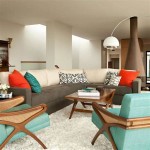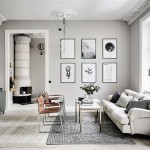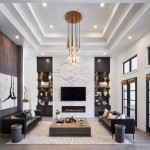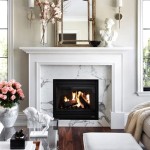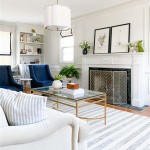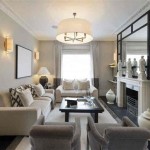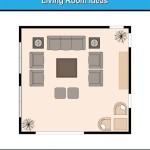How to Fill a Big Living Room: A Comprehensive Guide
A large living room presents both an exciting opportunity and a significant challenge in interior design. The expansive space offers the potential for creating a truly impressive and comfortable environment, but it also requires careful planning and execution to avoid feeling empty, cold, or disproportionate. Successfully filling a big living room involves considering factors such as furniture arrangement, zoning, lighting, and incorporating elements that add warmth and personality.
Establishing Clear Zones and Focal Points
One of the most crucial aspects of filling a large living room is dividing the space into distinct zones, each serving a specific purpose. This prevents the room from feeling like a vast, undefined area and allows for a more organized and functional layout. Consider the various activities that will take place in the living room, such as conversation, relaxation, entertainment, or even dining, and allocate dedicated zones for each.
For instance, a conversation zone might feature a sofa, armchairs, and a coffee table arranged around a fireplace or a large area rug. An entertainment zone could center around a television and include comfortable seating and storage for media equipment. A reading nook might consist of an armchair, a floor lamp, and a bookshelf tucked into a corner. A dining zone, if desired, could incorporate a dining table and chairs, ideally positioned near a window or a well-lit area.
Once the zones are defined, establishing focal points within each zone is essential. A focal point is a visual anchor that draws the eye and adds interest to the space. In a conversation zone, the focal point might be a striking piece of artwork, a unique fireplace, or a large window with a scenic view. In an entertainment zone, the television itself often serves as the focal point, but it can be enhanced with aesthetically pleasing media storage solutions. In a reading nook, a statement floor lamp or a gallery wall above the bookshelf could act as the focal point. Defining these zones and focal points creates visual interest and guides the flow of movement throughout the room.
The size and placement of furniture within each zone should be proportional to the overall dimensions of the living room. Avoid using small or sparsely distributed furniture, as it will only accentuate the vastness of the space. Opt for larger pieces that can comfortably fill the area and create a sense of balance. The spacing between furniture items should also be carefully considered. Leaving too much space can make the room feel empty and disjointed, while overcrowding can create a cluttered and uncomfortable atmosphere. Aim for a balance that allows for easy movement and comfortable interaction.
Utilizing Large-Scale Furniture and Decor
To effectively fill a large living room, it is necessary to incorporate furniture and decor that are appropriately scaled to the dimensions of the space. Using small or undersized pieces will only make the room feel disproportionate and incomplete. Opting for larger furniture items can help to create a sense of balance and visual impact.
Instead of a standard-sized sofa, consider a sectional sofa or a large modular sofa that can accommodate multiple people and fill a significant portion of the seating area. Alternatively, two smaller sofas placed opposite each other can also create a balanced and inviting arrangement. Armchairs should also be generously sized, providing ample space for comfortable seating. Consider adding large ottomans or poufs that can serve as extra seating or footrests.
Coffee tables and side tables should also be appropriately sized to complement the sofas and armchairs. A large coffee table can serve as a central gathering point and provide ample surface area for drinks, books, and decorative items. Side tables should be strategically placed next to seating areas to provide convenient surfaces for lamps, reading materials, and personal belongings.
In addition to furniture, large-scale decor can also play a significant role in filling a big living room. Consider incorporating oversized artwork, such as large canvases or framed prints, to create a dramatic visual impact. Large area rugs can help to define zones and add warmth and texture to the floor. Tall floor lamps can provide ambient lighting and add vertical interest to the space. Large plants, such as trees or statement ferns, can bring a touch of nature indoors and fill empty corners.
When selecting decor, it is important to choose items that are visually interesting and complement the overall style of the room. Avoid cluttering the space with too many small or unrelated items, as this can create a sense of chaos and overwhelm the eye. Instead, focus on selecting a few carefully chosen pieces that will make a statement and add personality to the room.
Adding Warmth and Personality with Textures, Colors, and Lighting
A large living room can sometimes feel cold and impersonal if it lacks warmth and personality. Incorporating various textures, colors, and lighting techniques can significantly enhance the ambiance and create a more inviting and comfortable atmosphere.
Textures play a crucial role in adding visual interest and tactile appeal to a space. Consider incorporating a variety of textures through fabrics, rugs, and decorative accessories. For example, a plush velvet sofa can be paired with a woven area rug, linen throw pillows, and a chunky knit blanket. Adding textured wall coverings, such as wallpaper or textured paint, can also add depth and dimension to the room.
Color is another powerful tool for creating a desired mood and atmosphere. While neutral colors can create a sense of spaciousness and tranquility, they can also feel bland and uninviting if not balanced with pops of color. Consider adding accent colors through artwork, throw pillows, rugs, and decorative accessories. Warm colors, such as reds, oranges, and yellows, can create a sense of warmth and energy, while cool colors, such as blues, greens, and purples, can promote relaxation and serenity. The choice of colors should be guided by the overall style and the desired mood of the living room.
Lighting is essential for creating a layered and inviting atmosphere. A large living room requires a combination of ambient, task, and accent lighting to adequately illuminate the space and highlight its features. Ambient lighting provides general illumination and can be achieved through overhead fixtures, such as chandeliers or recessed lighting. Task lighting provides focused illumination for specific activities, such as reading or working, and can be achieved through table lamps, floor lamps, or pendant lights. Accent lighting highlights specific features, such as artwork or architectural details, and can be achieved through spotlights or track lighting.
Layering different types of lighting allows for greater control over the ambiance of the room and creates a more dynamic and visually appealing environment. Dimmers can be used to adjust the intensity of the lighting to suit different moods and activities. Incorporating natural light is also crucial for creating a bright and airy atmosphere. Maximize natural light by keeping windows unobstructed and using light-colored window coverings.
Personal touches, such as family photos, travel souvenirs, and collections, can also add warmth and personality to a large living room. Display these items thoughtfully and strategically to create a sense of connection and belonging. Avoid cluttering the space with too many personal items, but rather curate a selection of pieces that are meaningful and visually appealing.
In addition to the above, consider adding architectural details such as crown molding, wainscoting, or built-in bookshelves. These features can add character and visual interest to the room and help to break up the monotony of large, blank walls. They also offer opportunities for displaying artwork, books, and other decorative items.
By carefully considering these elements - zoning, large-scale furniture, textures, colors, lighting, and personal touches - a large living room can be transformed into a comfortable, inviting, and visually stunning space that reflects the unique style and personality of its occupants.

10 Tips For Styling Large Living Rooms Other Awkward Spaces The Inspired Room

10 Tips For Styling Large Living Rooms Other Awkward Spaces The Inspired Room

13 Tricks To Decorating A Large Living Room

9 Tips To Help Decorate Large Spaces Real Estate Hsa

25 Cozy Living Room Tips And Ideas For Small Big Rooms Holmes St Clair

10 Tips For Styling Large Living Rooms Other Awkward Spaces The Inspired Room

How To Decorate A Large Living Room Peninsula

15 Decorative Living Room Furniture Layouts Taskrabbit Blog

5 Stylish Ways To Fill Up Your Large Living Room Wall

How To Decorate A Large Blank Wall Nth Degree Interior Designs Dublin Oh
See Also

